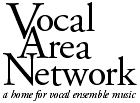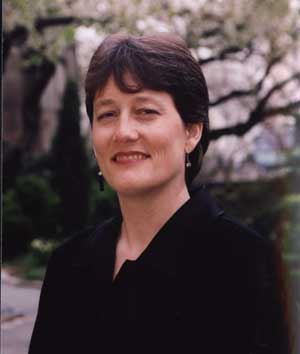 |
 |
Advertise | Sustaining Membership | VAN Store | Feedback
by Kristina Boerger for Vocal Area Network
Posted September 11, 2006
 While
all the pieces on Amuse's September 21st concert program have been created or
adapted for performance in the Western choral art tradition, several call the
definition of this tradition into question. Some originate in regions that may
only sometimes be considered part of "the West," and some represent
musical behaviors that -- however occidentally situated -- fall outside of what
is typically meant by "Western art" or "Western
civilization."
While
all the pieces on Amuse's September 21st concert program have been created or
adapted for performance in the Western choral art tradition, several call the
definition of this tradition into question. Some originate in regions that may
only sometimes be considered part of "the West," and some represent
musical behaviors that -- however occidentally situated -- fall outside of what
is typically meant by "Western art" or "Western
civilization."
I built this program out of my stubborn desire for Amuse to perform on the same evening two beloved and sharply contrasting pieces: Fauré's Messe basse and Stravinsky's Four Russian Peasant Songs. Both are brilliant distillations of their composers' most recognized stylistic language, rendered for treble voices in clean, stark texture. But they have in common none of the usual things -- nationality, style, textual content -- around which one typically builds a coherent concert program. It took me longer than usual to come up with a design.
Eventually I recognized the source of my difficulty. These two pieces were inspired by contexts that in the West are typically held in opposition to each other: the contemplative, indoor expressions of the cultivated church musician and the kinetic, outdoor expressions of the rustic. So I decided to organize the concert by geographical region, and from each region I selected examples of music influenced by the Christian liturgy and examples of music influenced by local Pagan life.
The Pagan -- or the Heathen -- are simply the "people of the heath," country-dwellers worshipping their earth-bound gods. That these words also carry the flavor of the epithet is testament to the success of institutional Christianity in subduing and marginalizing people of such traditions. Though we may begin our "Western origin myth" in pagan Greece, we cannot conceive of contemporary Western culture without the organizing influence of the Church. After all, we reckon our own continent's annexation to "the West" after the travels of a sailor funded by the infamous Christian zealots Ferdinand and Isabella. And so: even where Pagan cultures (the Saami, the Hopi, the Aymara) still manage to live along the same longitudinal coordinates as Western Christians, they are not what we call "Westerners."
The liturgical singing of Latin Mass parts and motets is assumed to be undertaken while sitting or standing still. So much rustic music, on the other hand, is inseparable from dance, or from the physical movements of labor. On this concert, then, you will hear: music of the empire and music of the tribe; the harmonies of chaste contemplation and the rhythms of swaying hips; high-soaring lines for the gods of heaven and the earthward stamp of feet; music of transcendence and music of immanence… and some music reflecting a conversation between these two worlds.
Our concert begins in Western Europe with Gabriel Fauré's brief Mass for a low service, which omits the wordy Credo and Gloria. Consisting mostly of unison lines or a melody and countermelody over harmonies in the organ, these lyrical prayers are clear kin to Fauré's mélodies for solo voice and piano, so adored for their sweetness and simplicity.
As a bookend to these prayers, we offer three motets of Brahms who, though no Christian himself, felt responsible for composing in the great genres of his forbears: sonata, symphony, concerto, and that ancestor of them all: sacred choral polyphony. Interestingly enough, the most difficult programming task of this concert was to find a piece from Western Europe based on rustic dance or some other kinetic, musical evocation of peasant life. Such pieces do exist (most especially those romanticizing Gypsy life), but subjecting my choices to the requirement that the piece be a cappella and rendered for treble voices eliminated most possibilities. I interpreted this difficulty as a sign of how thoroughly "high culture" in the West has succeeded in defining itself against the "ethnic," the rural, the "folkloric." I settled finally on Hassler's Tanzen und Springen. Though this piece was created for enjoyment by Europe's educated, urban elite, who sight-read part-songs for entertainment at social gatherings, its jaunty triple meter is likely the descendant of peasant dance, and its lyrics suggest a merry encounter with players of portable, outdoor instruments.
Next we travel to the region of Stravinsky's Four Russian Peasant Songs, beginning with prayers by Alexander Kastalsky and Pavel Chesnokov in the lush, steady triads so easily recognized as Russian Orthodox homophony. Stravinsky shocks by contrast with his irregular meters, percussive rhythms, and near-total avoidance of triads. Like his Les noces, this music is meant to sound as though it came from the Russian countryside without actually quoting extant music. Although wholly original, the songs' jagged metrical structure and their revolving melodic fragments are imitations of Russian folk themes. The texts are traditional and would have been sung during fortune-telling rituals at the Winter Solstice.
To Hungary, then, and its neighbor, Slovenia. In this region of the world, there is no shortage of peasant-based music for a cappella, treble choir. Remember that Hungary's first composers of stature in the Western art tradition -- Bartók and Kodály -- also distinguished themselves by traveling throughout the Eastern European countryside, collecting thousands of traditional songs. They brought these repertoires to the attention of the concert-going West by adapting traditional songs for the concert stage. Furthermore, there is a thriving tradition of youth-choir education and treble-choir performance in this region that owes much to Kodály the pedagogue. So we have Jakob Jez, after Kodály's example, arranging the peasant dance tunes of his own country for performance by treble choir. The Mass in A of living Hungarian Miklos Kocsár is published by the Kodály Pedagogical Institute. When we compare this sacred piece to the Brahms and the Fauré, we find it much more kinetic. This is largely because Kocsár constantly changes meter, a freedom claimed by 20th-century composers to disrupt the regularity of pulsar emphasis. I cannot resist pointing out that the first piece to gain infamy in the West for this practice was Rite of Spring, Stravinsky's evocation of Pagan ritual.
Now we travel further West to South America, and the only piece in the set that would be identified as "Western" is the one whose sound fails to place it on the same continent with the other two. The Ave Maria of living Venezuelan César Alejandro Carrillo is a motet firmly rooted in the European tradition. Like the Fauré and the Brahms, its text is in the official language of the Holy Roman Empire. Its harmony is based in triads (and inflected with more contemporary added tones), its rhythm is consistent, and its meter is undisturbed. It entices at first with its limpid, ruminative chords that ultimately peal out, striving for heaven, before returning to an interior repose. In contrast, the next sacred piece is based in the Yoruba traditions of Brazil. This Pagan faith system was brought to the Americas in the bodies of West African slaves and is known in Brazil as Macumba or Candomblé (and in Cuba and Puerto Rico as Santería). Its adherents trust in a pantheon of deities -- called orishas -- each one associated with a different aspect of the natural world and governing particular human dynamics or states of being. Each orisha also has his or her own specific rhythms that the faithful will drum and dance in order to summon him or her. Jayme Ovalle's Shangó is a song to the eponymous god of thunder. I could not find any literature about the piece, but the opening melody sounds stylistically similar to orisha songs I know, and so it may be traditional. The use of choral harmony, however, is a Western classical overlay. And while we will not be dancing while singing the piece, the underlying rhythms of dance are audibly implied. So, too, for Atahualpa Yupanqui's famous Duerme, negrito, arranged by Venezuelan Emil Solé. The Argentine-born Yupanqui (1908-1992) is remembered as one of Latin America's most beloved folk musicians and Leftists. About Duerme, negrito, this arrangement's editor, Maria Guinand, writes: "the little Black child is given impossible promises and warned of dire consequences, while the sad plight of the sick, hardworking mother is depicted in word and song." As in so much music from cultures in which there is no singing without dancing, even words about the most sorrowing conditions are sung to lilting, festive tunes. Here, the choral accompaniment's interlocking and syncopated rhythms simulate the slapping of palms on drum skins, which in Afro-Latin cultures is always a call to dance.
We finish our tour in Scandinavia. Einojuhani Rautavaara is Finland's preeminent living composer, having distinguished himself particularly in opera. His opus for chorus includes Latin motets, works based on the Kalevala (the Finnish national epic), and his acclaimed Suite de Lorca. We are presenting the Kyrie and the Agnus Dei from his Lapsimessu. In the full form of the Mass, each prayer is followed by a string interlude, whose function would seem to be an extension of the contemplative space opened by the singing. From here we go to Norway for a dance tune whose verses may indicate the encroachment on peasant festival of Christian prohibitions against dancing - particularly that of women: Kari goes to the village dance and accepts an invitation to the floor from the tall, dark stranger (the Devil?), who whirls her faster and faster about the room until she falls down dead. We present this tune after its rendering into harmony by the Norwegian folk trio Tiriltunga.
Our last selection is built on a folk hymn from Sweden, In Heaven's Hall. Composer Karin Rehnqvist places this praise of the Lord God of Hosts in the mouth of the herder who stamps across the mountainside as church bells peal below. The melody marches inexorably forward in unison or with simple countermelody, punctuated by tolling clusters and rising skyward through channels flung open by kulning, the high, keening sound of the herder's traditional call. Thus are the peasants and the preachers united on our concert stage to resolve this evening of putative opposites.
"Praying and Dancing" will be presented by Amuse at 7:30 PM on September 21, 2006 at the Church of St. Ignatius of Antioch, 87th and West End Avenue. For details, visit www.amusesingers.org.
Kristina Boerger is the director of Amuse.